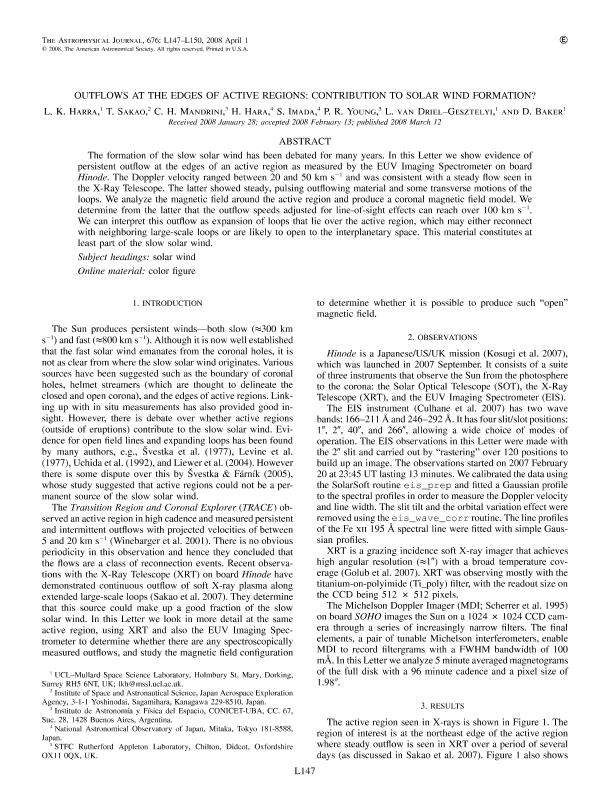Mostrar el registro sencillo del ítem
dc.contributor.author
Harra, L. K.
dc.contributor.author
Sakao, T.
dc.contributor.author
Mandrini, Cristina Hemilse

dc.contributor.author
Hara, H.
dc.contributor.author
Imada, S.
dc.contributor.author
Young, P. R.
dc.contributor.author
van Driel Gesztelyi, Lidia

dc.contributor.author
Baker, D.
dc.date.available
2017-07-20T20:03:27Z
dc.date.issued
2008-12
dc.identifier.citation
Harra, L. K.; Sakao, T.; Mandrini, Cristina Hemilse; Hara, H.; Imada, S.; et al.; Outflows at the edges of active regions: Contribution to solar wind formation?; IOP Publishing; Astrophysical Journal; 676; 2; 12-2008; 147-150
dc.identifier.issn
0004-637X
dc.identifier.uri
http://hdl.handle.net/11336/21033
dc.description.abstract
The formation of the slow solar wind has been debated for many years. In this Letter we show evidence of persistent outflow at the edges of an active region as measured by the EUV Imaging Spectrometer on board Hinode. The Doppler velocity ranged between 20 and 50 km s^-1 and was consistent with a steady flow seen in the X-Ray Telescope. The latter showed steady, pulsing outflowing material and some transverse motions of the<br />loops. We analyze the magnetic field around the active region and produce a coronal magnetic field model. We determine from the latter that the outflow speeds adjusted for line-of-sight effects can reach over 100 km s^-1. We can interpret this outflow as expansion of loops that lie over the active region, which may either reconnect with neighboring large-scale loops or are likely to open to the interplanetary space. This material constitutes at<br />least part of the slow solar wind.
dc.format
application/pdf
dc.language.iso
eng
dc.publisher
IOP Publishing

dc.rights
info:eu-repo/semantics/openAccess
dc.rights.uri
https://creativecommons.org/licenses/by-nc-sa/2.5/ar/
dc.subject
Sun; Magnetic Fields
dc.subject
Sun: Solar Wind
dc.subject.classification
Astronomía

dc.subject.classification
Ciencias Físicas

dc.subject.classification
CIENCIAS NATURALES Y EXACTAS

dc.title
Outflows at the edges of active regions: Contribution to solar wind formation?
dc.type
info:eu-repo/semantics/article
dc.type
info:ar-repo/semantics/artículo
dc.type
info:eu-repo/semantics/publishedVersion
dc.date.updated
2017-07-18T17:16:57Z
dc.journal.volume
676
dc.journal.number
2
dc.journal.pagination
147-150
dc.journal.pais
Reino Unido

dc.journal.ciudad
Londres
dc.description.fil
Fil: Harra, L. K.. Mullard Space Science Laboratory; Reino Unido
dc.description.fil
Fil: Sakao, T.. Institute of Space and Astronautical Science; Japón
dc.description.fil
Fil: Mandrini, Cristina Hemilse. Consejo Nacional de Investigaciónes Científicas y Técnicas. Oficina de Coordinación Administrativa Ciudad Universitaria. Instituto de Astronomía y Física del Espacio. - Universidad de Buenos Aires. Facultad de Ciencias Exactas y Naturales. Instituto de Astronomía y Física del Espacio; Argentina
dc.description.fil
Fil: Hara, H.. National Astronomical Observatory of Japan; Japón
dc.description.fil
Fil: Imada, S.. National Astronomical Observatory of Japan; Japón
dc.description.fil
Fil: Young, P. R.. Rutherford Appleton Laboratory; Reino Unido
dc.description.fil
Fil: van Driel Gesztelyi, Lidia. Centre National de la Recherche Scientifique. Observatoire de Paris; Francia
dc.description.fil
Fil: Baker, D.. Mullard Space Science Laboratory; Reino Unido
dc.journal.title
Astrophysical Journal

dc.relation.alternativeid
info:eu-repo/semantics/altIdentifier/url/http://iopscience.iop.org/article/10.1086/587485
dc.relation.alternativeid
info:eu-repo/semantics/altIdentifier/doi/http://dx.doi.org/10.1086/587485
Archivos asociados
